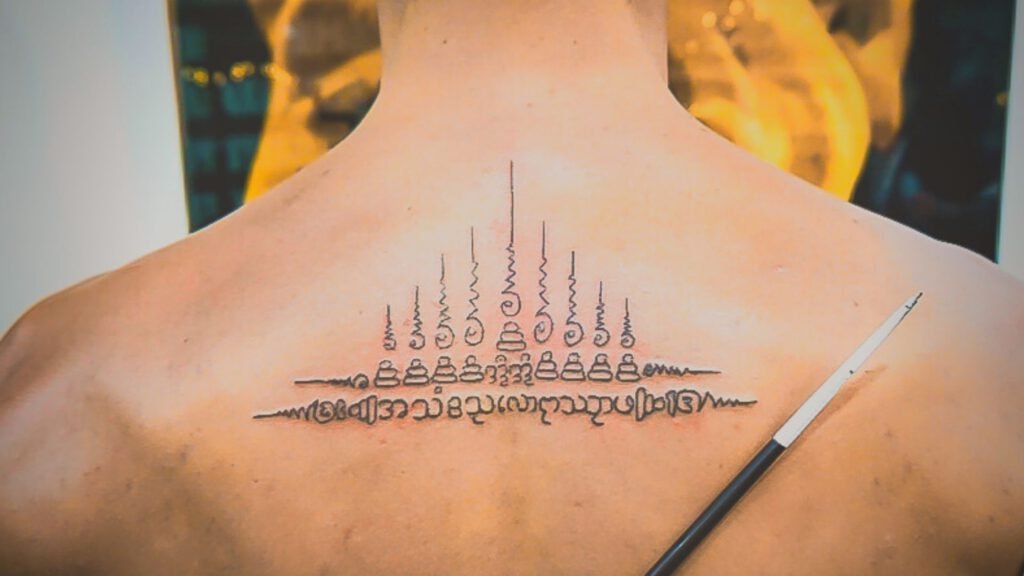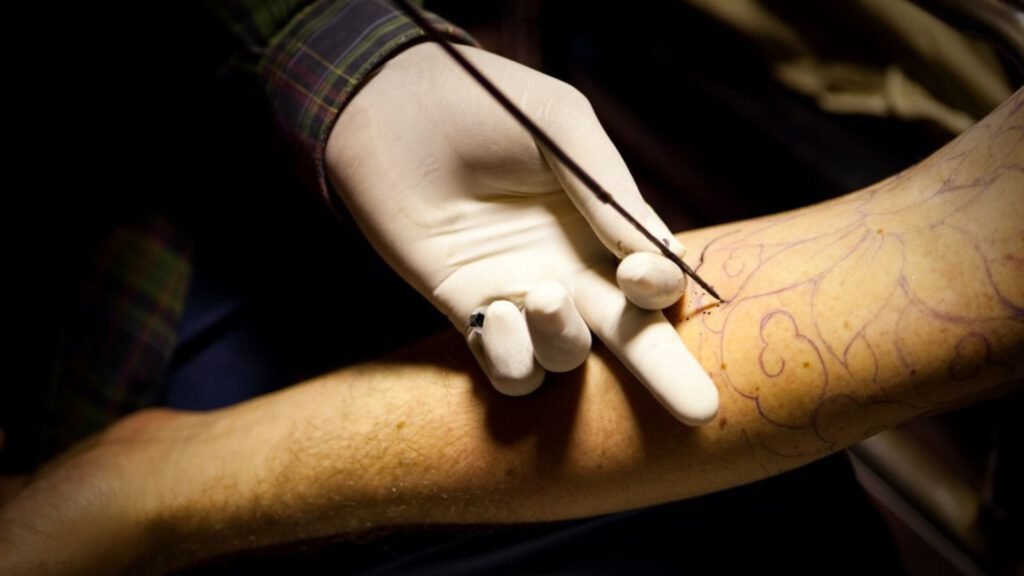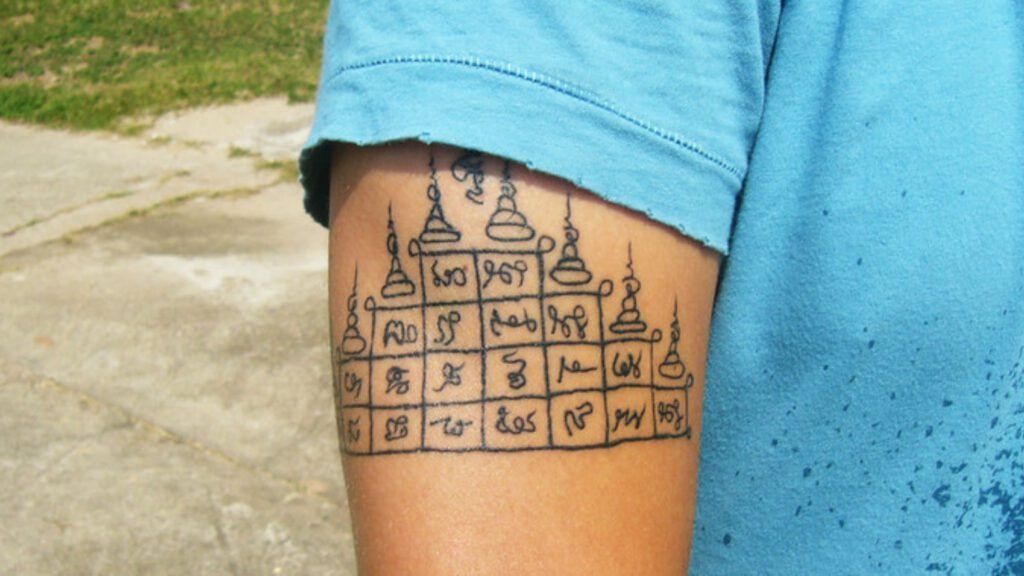Are you considering getting a Sak Yant tattoo? If so, you’re in the right place.
This complete guide will teach you everything you need to know about these sacred tattoos — from their meanings to the process of getting one.
We also offer 9 popular Sak Yant tattoo designs for you to check out.
Keep reading to learn more!
What Is Sak Yant Tattoo?
Sak Yant tatoos are ancient southeast Asian talismans believed to endow the wearer with magic gifts of luck, strength and protection.
These designs typically contains geometry, animals or deities and are commonly known as bamboo tattoos due to the traditional needles used.
The ritual of receiving a Sak Yant tattoo is very mystical and has deep connections among the local cultures with each tattoo being a unique affirmation or goal that the wearer wants.
The Sak Yant is made up of a combination of imagery and ancient texts unique to the individual and are specially handcrafted by an Arjan.
An Arjan is a local priest who has studied the Sanskrit language for years in order to be able to craft unique talismans suited to each person they ink.
The text is usually Pali script, an unspoken language which still has deep mystical and symbolic meanings dating back thousands of years.
Each tattoo is unique with deep ties to the individual, meaning that a Sak Yant cannot simply be copied from one to another.
Each Sak Yant tattoo has personal qualities such as asking for help in being successful in business, help in rehabilitation, or even help to bring luck into their love lives.

What Does Sak Yant Mean?
Sak Yant literally means Tattoo Yantra — a tattoo with a mantra or enchantment.
It uses geometric shapes, images of animals and deities to bring the enchantments to life, or to activate them during the ritual in which a magical incantation or “Kata” is chanted onto a persons body.
This is often written in Sanskrit although has been seen written in other ancient languages.
We will look at the ritual process later on.
How Old Is Sak Yant Tattooing?
Sak Yant tattoos date back two thousand years, with links all across south eastern Asia, from China, Thailand, Vietnam and the Philippines.
The Sak Yant is very diverse and comes in many shapes, sizes, and forms — each with different lineages depending on the school of training the Arjan attended.
This makes the Sak Yant difficult for other Arjans and especially anyone not trained in the ritual to understand the artwork that is the Sak Yant.
Historically, the Sak Yant was created by local priests on the bodies of warriors before battle in shamanistic rituals, this was done head to toe as to stop any harm coming to them from spears and swords.
This is also seen across other cultures with amulets and talismans created by priests for the same role.
Historically, warriors would be seen as pocessing great strength and even immortality if they were adorned with these tattoos.
In more recent history Soldiers of World War two, Korea and Vietnam have embraced these traditions, becoming the “Taharn Phee” or Ghost Soldiers.
These ideas of modern Ghost soldiers likened to ancient powerful and immortal warriors only adds to the mysticism of the Sak Yant.

Sak Yant Tattoos Today
Today, you can see some Muay fighters who have inked themselves with Sak Yant tattoos in hopes of giving themselves an advantage over their opponent and powers of protection and strength.
The mystic, magical and even shamanistic beliefs around the Sak Yant have had positive and negative reviews recently with celebrities like Angelina Jolie getting one adding to the popularity of the tattoo as well as bringing the more rural tradition back into mainstream culture in Thailand,
However, many Buddhist monks and conservatives have pushed to have it stopped and removed from Buddhism entirely, despite previously being generally accepted, even if not actually a fundamental core of Buddhism.
Some conservatives in Thailand have even gone as far as suggesting the process and tattoo itself is “Trashy” due to the new popularity it has found — especially amongst westerners.
Many of the tattoos critisized, are the ‘copy and paste’ tattoos which are without meaning or understanding, and seen as just another tattoo, unfortunately adding to the stereotype of the trashy tattoo worn by the west.
Is Sak Yant Tattooing Religious?
Yes, the Sak Yant has religious elements, from the religious and mystical shapes, images and texts to the idea that it will give you powers and also give you a greater connection to the cosmos and higher powers.
Sak Yant and Buddhism are deeply connected in some ways, from the idea of the spirt and leading the four elements to the idea of being an element in leading you towards Nirvana — the goal of true enlightenment.
Buddhists believe that this goal of Nirvana is unique and individual, like the Sak Yant.
Similarly, the journey as well as the elements of the Sak Yant, for example asking for help with addiction, brings us closer to the cosmos and all those that are in it.
Another connection to the Buddhist religion is the use of geometric circles and shapes. This is believed to be the “Karmic cycle” of life and death — the undertone for Buddhism which is reincarnation until true enlightenment or Nirvana.
However, Sak Yant tattooing is not always religious, the Sak Yant is cultural and communal, bringing more rural communities together especially those in dangerous jobs through tradition and ritual.
Although the modern Sak Yant is becoming common amongst non-Buddhists, it has started to lose some of the more religious aspects that it used to.
However, the process and rituals surrounding the attainment of a Sak Yant and activation of the powers remain.

How Are Sak Yant Tattoos Done?
No machines are used in the traditional Sak Yant, only sharpened bamboo dipped into ink.
This is painful and so a lot of modern Sak Yant’s are done with replaceable metal needles that look like the traditional ones.
Traditionally, the bamboo rods hold immense protective and mystical power over people as well as the Sak Yant, however, it also is extremely painful and tends to not be as permanent as many would like.
Therefore, modern techniques and tools are often used these days — more than the traditional bamboo rods.
This more modern process can take place at any tattoo shop.
However, there is some disagreement over the authenticity of a Sak Yant if it does not come from a “real” Arjan and temple.
The modern method, like its traditional version, uses a needle, although this “Kem” metal rod is also seen as magical tool, with a comparison made to it being like a magic wand in the west.
Where Can You Get A Sak Yant Tattoo?
Traditional Sak Yant tattoos take place in ornate temples by Arjans.
These Arjan are trained monks whose skills were passed on through specific schools, taught by those who created the Sak Yant tattoos before them, often it is a family vocation.
Before an Arjan can practice Sak Yant, they must fully learn Pali, the sacred language used in Sak Yant, along with many other languages and alphabets to ensure they have all the tools needed to complete yantra designs.
In the process of training, they go from student to master by gaining the Ruesi mask, life as an Arjan is different to the typical monk as it does not have many of the same restrictions as does the hooded life of a monk.
The Arjan do not do this for money. However, some do ask for donations and gifts to help with the upkeep and maintenance of the temples and other Arjans. This could be anything from flowers, incense or even cigarettes.
Not presenting a gift to the temple along with many other things could give the Arjan reason enough to refuse to ink you, so be careful.
Inside, depending on how early or late you arrive you could have to wait for your turn.
However, these days you can also get Sak Yant tattoos at many regular tattoo shops. These will likely be less painful but will also lack some of the cultural richness that is involved in the Sak Yant.

What To Expect During A Sak Yant Tattoo
Initially, you will be laid down and made comfortable while the Arjan recites short prayers or Yantra.
The Arjan will repeatedly poke you with the needle and ink — eching the chsoen patten that you will have discussed beforehand into your skin.
During the tattoo, the Arjan will likely chant the Kata to engage the enchantment for protection. This is done to release and activate the power within the Pali script written onto the skin in ink.
This whole process, from start to finish, is wrapped in local and regional mysticism and ancient beliefs.
Can Anyone Get A Sak Yant?
Yes, anyone can technically recieve a Sak Yant tattoo.
However, Arjans do have some specific rules regarding who they are allowed to tattoo.
For example, they are not allowed to touch women so they must use gloves or other clothing while creating the tattoo.
Women also must not be tattooed within the temples. Some Arjan will happily tattoo women outside of the temple, though.
Similarly, the Sak Yant will not be tattooed below the waist besides some designs on men’s thighs.
For women, no tattoo is allowed below the waist or on the feet.
The Design Of Sak Yant Tattoos
The spiritual origins of the Sak Yant are very similar to other cultures from across the globe.
The four primal and forceful elements, Fire, Water, Earth and Air, but these are all connected through a fifth side, the spirit or the Buddha as later known.
This gives the common shape seen across many popular Sak Yant designs — the five sided star or the five script lines of the Hah Taew.
Specific designs like the Hah Taew date back 700 years in northern Thailand in which was originally written in the ancient Khmer language of Khom.
Over time the Khom language was replaced with Sanskrit and other languages of which lose the majority of the tattoos meaning and the uniqueness of the tattoo.
Keep reading to see some of the most popular sak Yant designs.

9 Popular Sak Yant Designs
There are many different designs of tradional Sak Yant tattoo.
Here we will cover a few of the most popular ones.
Hah Taew
The Hah Taew is the most common and popular Sak Yant — popularised in the west by Angelina Jolie.
The basic design is five lines of Pali script — each one with a different enchantment, be it either protective or to increase your personal skills and luck.
But the Hah Taew is very personal in meaning. It cannot be copied without losing its importance or meaning.
The most popular and common description goes like this:
- Line 1: Protects from unjust punishment and protects your home.
- Line 2: Protect against bad luck.
- Line 3: Prevents Curses against you.
- Line 4: Energises your own good luck, fortune, ambition and lifestyle.
- Line 5: Increases your charisma.
This is understandably the most common as it seems to cover all the basis and is a great place to start. Plus, it looks great.

Gao Yord
The Gao Yord is many people’s favourite Sak Yant tattoo design.
Known as the nine peaks Yant, this is quite typical when it comes to Sak Yant tattoos.
It is also known as the master Yant and usually sits along the back atop the spine.
This design is believed to give a person great protection from violence and general harm while also representing kindness and popularity.
The nine peaks of Gao yord represent the peaks of mount Neru a mountain which is believed to be the centre of all physical, metaphysical and spiritual worlds connecting directly to the path of Nirvana and true enlightenment.
The connection to the path of Nirvana gives it the connection to Buddhism and to a spiritual plane which we talked about earlier in its connections to religion and spirituality.

Paed Tidt
The Paed Tidt or “eight directional Yant” consists of eight different points — each one representing one of the eight directions of the universe according to Buddhists.
The eight sides are: the right view, right intention, right speech, right conduct, right livelihood, right effort, right mindfulness and right concentration. These eight rights of the universe are considered the undertones of Buddhism.
The Kata inside of the eight points is the enchanted circle which bestows the protections and blessings onto the person while the eight directional images are often of the Buddha, again linking directly into the beliefs and culture of the Buddhists.
The Buddha symbol which surrounds the Kata is known as the Yant Ongk pra. This can be tattooed by itself but is usually adoring other tattoos such as the Paed Tidt or the Gao Yord.
The Yant Ongk Pra usually has another tattoo placed above it known as the Unalome — the unwavering path to enlightenment.

Suea Sak Yant
The twin tiger design is common, especially among fighters and those with dangerous jobs.
It represents the power and struggle of many and bestows strength and conviction.
So, if you seek extra power in your life then this may be the magical tattoo for you.

Dtao Ruen
The Dtao Ruen means “turtle house” and offers the wearer wealth and good luck. It is believed to remove emotional suffering from your life.
The turtle tattoo refers to the Buddha and from the times when the Buddha reincarnated into a turtle which grew and grew.
In other myths, the turtle is deeply connected with the earth as it is said to be an embodiment of the earth element.
It is also said to have attributes such as patience, self-respect and a strong sense of independence.
This is a great design for those who are calm, patient, and hold an independent tenacity.

Na Hnaa Tong
A beautiful tattoo consisting of up to 108 different blessings, the Na Hnaa Tong represents popularity and wealth.
Some indivuals with this tattoo have reported their personal relationships with friends, lovers, family and at work colleagues great improving.
The intended idea of this tattoo is to attract friendly attention along with love and compassion, all while protecting you from harm, illness, and violence.

Yant Mangkorn Bung Pai
With this tattoo, you really could be the girl or boy with the dragon tattoo.
The mangkorn is designed to protect you from harm and bad luck while increasing your courage and confidence.
Often worn by those either in the military or government officials, it depicts the fire breathing dragon, a mythical beast which is feared for its destructive power.
This is believed to be harnessed and trapped within the Kata of the tattoo.

Phra Rahu
The Phra Rahu tattoo and its meaning is odd and different when compared to the others on this list.
The Phra Rahu is a demon of Hindu mythology that tried to eat the sun and moon.
This demon is supposed to eat the negative energy of others and so is actually considered positive, despite the description given.
Who doesn’t want a personal demon eating all the negative energy in their life, am I right?

Phra Pidta
Phra Pidta represents the closed eyes of Buddha, who is indifferent to temper and emotion.
It is believed to be an evolution of the god of fortune, therefore giving the wearer the blessing of wealth and success.
And doesn’t look too bad either!

Final Thoughts
The origins of the Sak Yant date back thousands of years and each design and style has its own unique history and stories.
This history and cultural significance make Sak Yant tattoos some of the most meaningful pieces of body art a person could recieve.
And, with so many designs, from the the Hah Taew to the Gao yord, there many options to find a Sak Yant design that is releavnt to you.
If you want something that stands out and brings you closer to the cosmos and Buddha, then consider seeking out a Sak Yant tattoo.
The culture and rituals around the Sak Yant are nothing short of amazing, but is also important not to forget the controversy surrounding.
If you are an outsider, then appraoch the culture and tradition surround Sak Yant tattoos with a deep respect.

